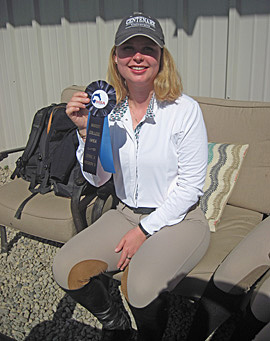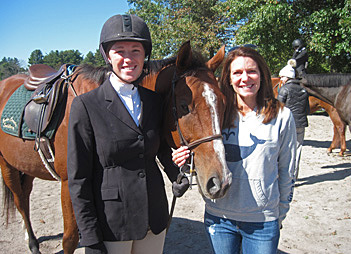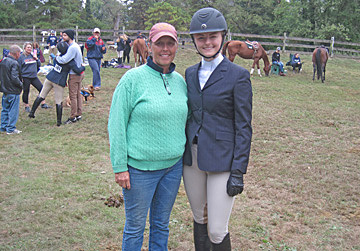|
||||||
|
THE NEW IHSA DIVISION NAMES CONVERSION TABLE When one thinks of "Rookies" they might think of someone involved in their first season of something, be it riding in the IHSA, playing professional sports or simply starting a new job among many co-workers with plenty of time in the same industry. When one thinks of "Limits" - especially when planning an IHSA show - they would usually be thinking of the number of rides that will be allowed at an upcoming show. An unlimited show has no limits, as a team could bring just about their entire roster to compete. But from now on these terms have a different meaning within the IHSA. There will be Rookies who may have spent time at a lower level, technically not making them Rookies in the first-year sense but they will be Rookies nonetheless. And when limiting the number of riders at shows there will perhaps be a limit on the number of "Limits" a school will be allowed to bring. When the horse flesh is in large supply there might be no limit on the number of limits taking part. Or if it is a point show a school will be limited to one limit in each of the two limit divisions. One needs no introduction? From now on they do if it is a hunter seat show and they want a full point card! Now forget all of that and pretend the story starts here: For the first time since 2003 (when what was for 16 seasons called the Novice Western Horsemanship division was added) the IHSA has re-named a riding division. In fact the IHSA has re-named five hunter seat and four western divisions for the 2019-20 season. "It was done to bring us in line with industry-standard names for similar division(s)," says Kelly Francfort, the head coach at Rutgers University and IHSA Vice-President. According to at least one other individual the name changes also help with marketing, as other organizations have used several of these names for divisions which made the IHSA stand out for using something less recognized in 2019. If you already know the fact that there are changes and simply want to see a list of the new names next to the old ones to figure out which is which then jump - or lope - ahead to the bottom of the page. But if you are hearing this for the first time and want to know which divisions are affected then read on for that information...
Let me introduce you to the introductory!: Riders who have never ridden a horse prior to college but who join a hunter seat team to ride in the beginner walk-trot division will now be known as "Introductory" riders. The division previously known as beginner hunter seat equitation or beginning walk-trot has been re-named introductory hunter seat equitation. On the Western side the name beginner western horsemanship remains intact. If you join a western team with no prior riding experience then you are in beginner western just as would have been the case last season. "Rookies" are the new western intermediates!: If you rode as a beginner western rider in 2018-19 and still needed a few points to class up and you earn these points at the first show of 2019-20 you will move up into the first of two Rookie levels. What was intermediate I is now rookie A. This is the level that will require a rider to earn 18 points to become a rookie B/formerly intermediate II and enough to reach 36 to point up another level and go to Regionals. Hopefully all the rookies learn to lope well enough over the course of earning their 36 combined A/B points to be truly ready for "Level I". What? I am a novice without pointing up??: The IHSA has kept the "Novice" name but applied it to what was previously the two walk-trot-canter divisions. Riders who pointed out of introductory/beginner previously would have shown in beginner walk-trot-canter, with the goal of getting to 18 points to ride at the advanced walk-trot-canter. If they got to 36 points in the two divisions they moved up into what was novice flat and fences. Today the first step among levels which require the canter is called "Pre-Novice." This name applies to the former beginner walk-trot-canter while simply "Novice" applies to advanced walk-trot-canter. Hunter seat riders need 18 points at the pre-novice to be novices, and when they go over 36 points in the combind divisions they move up, going into the division that used to be for novices. All across the IHSA there are riders who were close to pointing out of advanced walk-trot-canter to reach the novice levels as the 2018-19 season ended. Today these same riders start the year as novices if only for a short time. When they point up with 36 or more points they become...
Limits! The first hunter seat level which required one to jump was known as novice fences. From now on the term novice will not be applied to anyone jumping at an IHSA hunter seat show. The former novice levels are now the "Limit" levels. Though it might not flow off the tongue as gracefully when spoken, riders between the current novice levels and the intermediate levels are today called limits. A one and a two: Just as hunter seat riders can toss 'novice' and 'over fences' when put together out of their vocabulary so can western riders give the heave-ho to 'novice' and 'advanced.' What until recently was called novice western horsemanship will now simply be known as "Level I" western horsemanship. The division the novices were aiming to point into was advanced horsemanship. That division is now "Level II" western horsemanship. It will be a level playing field for some time for western riders who start at Level I, for after earning 36 or more points at I they will need another 36 or more at II to finally get into open. The Criteria for being placed at each of the new levels mentioned is the same as last season, with only the names changed if we have been informed correctly. Open Flat, Open Fences, Open Western Horsemanship, Open Reining, Intermediate Flat, Intermediate Fences, Beginner Western Horsemanship and all Alumni Divisions stay the same!: None of these divisions saw a name change over the summer, so if you are in these divisions or are getting close (some people graduate in December!) just go with the flow and help your teammates in the re-named divisions as best as you can. All IHSA divisions have a corresponding number, such as "16" to Open Reining and "5" to Intermediate Equitation on the Flat (most riders have seem these numbers printed into show programs while parents may have heard them when announced over public address systems at shows as part of the results). The Key or conversion table below lists each number followed by the new name of a division, which in turn is followed by the old name. If a division has not undergone a name change then "Unchanged" appears after the first name shown. This writer has already been to three official IHSA shows this season and it appears most are picking up on the changes without too much difficulty. The ones who have not should keep this list handy to avoid confusion. --Steve Maxwell New Division Names on the Left/Old Division Names on the Right 1 = Introductory Hunter Seat Equitation/Beginner Walk-Trot Equitation 2A = Pre-Novice Hunter Seat Equitation/Beginner Walk-Trot-Canter Equitation 2B = Novice Hunter Seat Equitation/Advanced Walk-Trot-Canter Equitation 3 = Limit Hunter Seat Equitation on the Flat/Novice Equitation on the Flat 4 = Limit Hunter Seat Equitation Over Fences/Novice Equitation Over Fences 5 = Intermediate Hunter Seat Equitation on the Flat/Unchanged 6 = Intermediate Hunter Seat Equitation Over Fences/Unchanged 7 = Open Hunter Seat Equitation on the Flat/Unchanged 8 = Open Hunter Seat Equitation Over Fences/Unchanged 9 = Alumni Equitation on the Flat/Unchanged 10 = Alumni Equitation Over Fences/Unchanged 11 = Beginner Western Horsemanship/Unchanged 12A = Rookie A Western Horsemanship/Intermediate I Western Horsemanship 12B = Rookie B Western Horsemanship/Intermediate II Western Horsemanship 13 = Level I Western Horsemanship/Novice Western Horsemanship 14 = Level II Western Horsemanship/Advanced Western Horsemanship 15 = Open Western Horsemanship/Unchanged 16 = Open Reining/Unchanged 17 = Alumni Western Horsemanship/Unchanged 18 = Alumni Reining/Unchanged
|
||||||
|
|
||||||
|
HOME
| CONTACT US |
||||||



